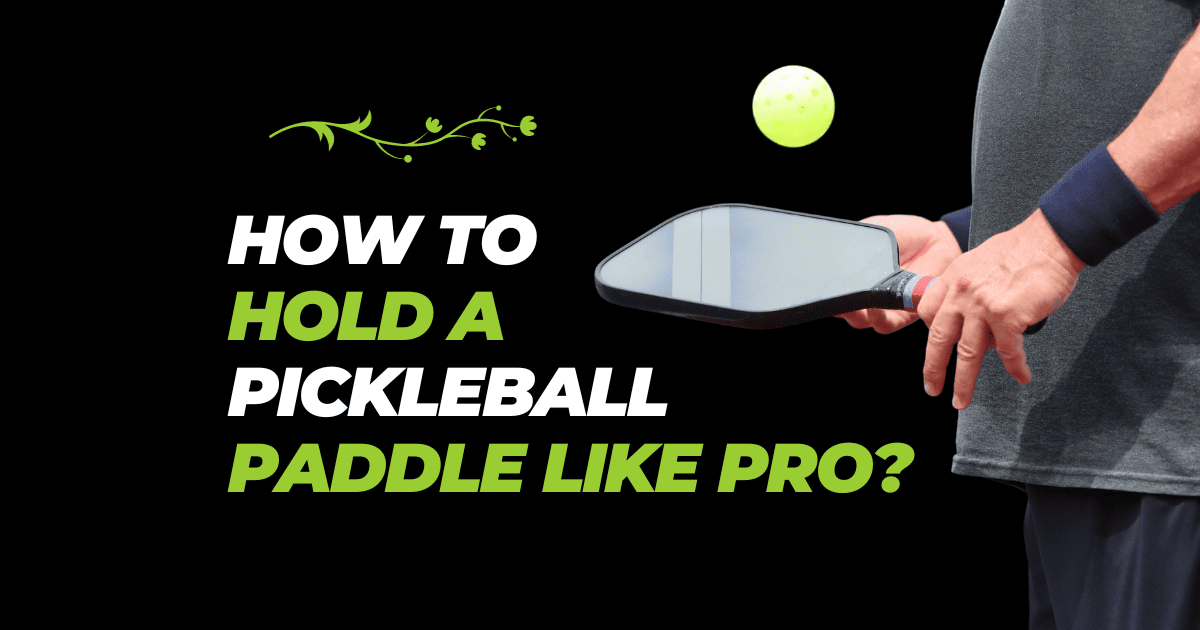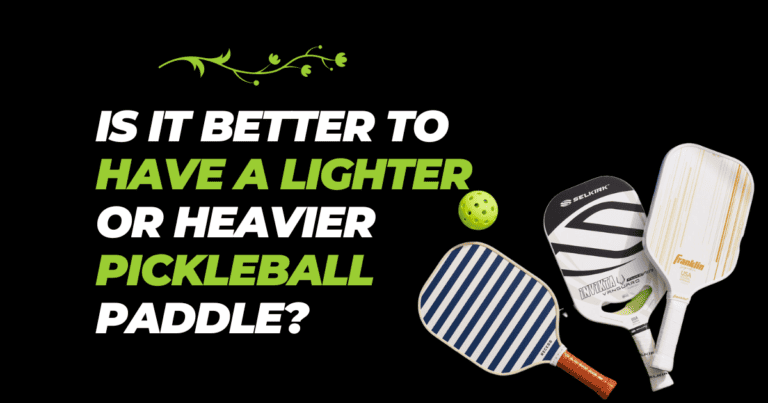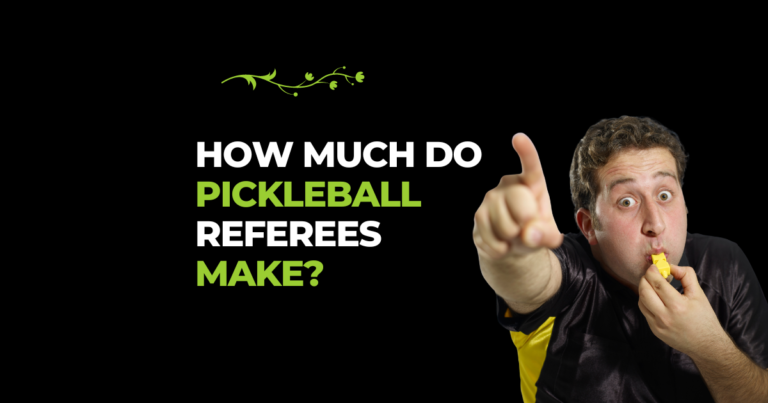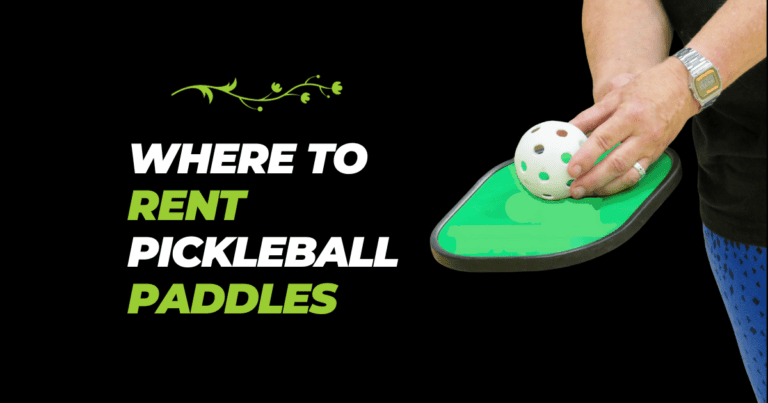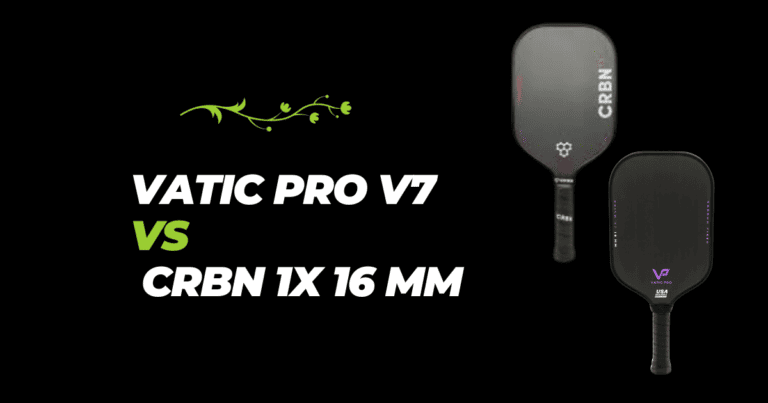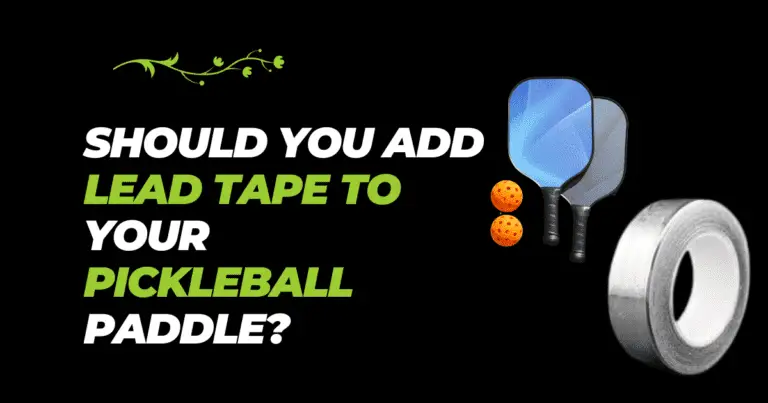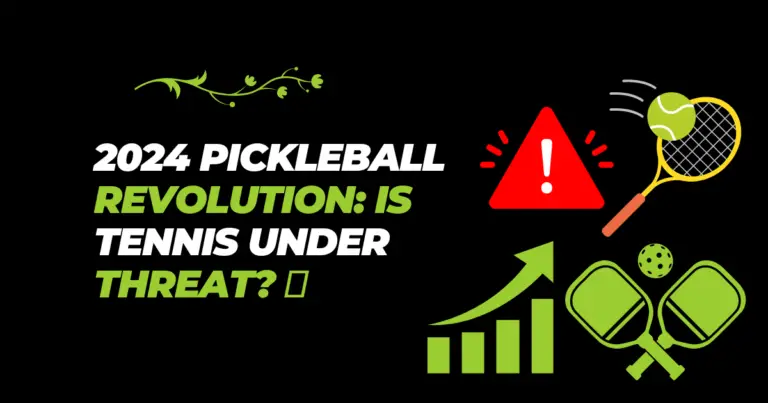Last updated on: September 20, 2025
Learning how to hold a pickleball paddle correctly is important for success on the court! Whether you’re a beginner picking up a paddle for the first time or a seasoned player looking to improve your game, proper grip technique will help you hit more accurate shots with better control. In this article, I’ll break down the basics of how to hold a pickleball paddle in just a few simple steps. So grab your gear and let’s get ready to master your pickleball paddle grip!
Before starting, here’s a quick overview of pickleball basics:
- 🎾 Played on a 20×44 foot court with a tennis-style net set at 34 inches
- 🥎 Uses a perforated plastic ball (wiffle ball)
- 🏸 Underhand serve hits diagonally into the service court
- 🎾 Serve must clear non-volley zone line
- No volleys are allowed in this zone
- 🎾 Games go to 11 points, win by 2
- 🤝 Double bounce rule – both sides must hit the ball
Now let’s get into the proper grip so you can start playing this addicting game!
Pickleball Paddle Parts
Pickleball paddles typically have 4 main parts:
| Part | Description |
| Face | Hitting surface made of various materials |
| Core | Inner layer providing paddle structure |
| Edge Guard | Protective trim around paddle edge |
| Handle | Grip area for holding paddle |
Paddle Face
This is the hitting surface you make contact with the ball on. The most common pickleball paddle face materials are:
- 🥎 Composite – Graphite and fiberglass blends
- 🌳 Wood – Materials like poplar or aspen
- 🏑 Polymer – Cushioned options like polypropylene
Composite paddle faces offer good touch and control for spins and placement.
Wood provides nice feel but durability varies.
Polymer gives added vibration dampening.
Paddle Core
The core provides stiffness and power in the center of the paddle. Common core materials are:
- 🥎 Nomex – Nylon-like material that’s rigid and lightweight
- ⛳️ Aluminum – Adds strength while keeping paddle light
- 🛢 Polypropylene – Polymer that increases durability
Nomex is a popular choice for its blend of stability and lightweight handling.
Aluminum offers excellent pop and touch.
Polypropylene provides a lot of sheer power.
Edge Guard
The edge guard goes around the rim of the paddle to protect it from chips and cracks. These are made from materials like:
- 🛡 Fiberglass – Provides good protection and stiffness
- 💨 Air Caps – Cushioned chambers reduce vibrations
- 🌳 Wood – Matches aesthetic and protects edges
Fiberglass is a standard and effective material for edge guards.
Air caps add comfort and cushioning.
Wood matches the faces of wood paddles.
Handle
This is the grip area you hold onto. Beach pickleball paddles often have a round paddle handle while standard models have more of an oval shape. The grip is usually made of:
- 🧱 Rubber – Provides excellent control and traction
- 🎈 Cushioned Foam – Absorbs sweat and vibrations
- 🧵 Synthetic Leather – Comfortable and long-lasting
Rubber is a popular choice for its sure-grip texture.
Foam cushions the handle and reduces hand fatigue.
Synthetic leather looks sleek and provides a comfortable grip.
Now that you’re familiar with the parts of a pickleball paddle, let’s go over the different grip techniques.
Step-By-Step Pickleball Paddle Grip
Follow these steps to grip your pickleball paddle properly:
1. Place the paddle handle in the palm of the hand
- Relax arm at side holding paddle upright
- Allow the handle to lay diagonally across the palm of the hand
- Let the pointer finger rest gently on the face of the paddle
2. Wrap fingers around the handle
- Curl the remaining fingers naturally around the paddle handle
- Lightly squeeze to secure the paddle in hand
- Avoid death grip clenching which creates tension
3. Position thumb on the neck of the handle
- The thumb should rest gently on the neck of the handle
- Pressure between thumb and pointer finger to secure paddle
4. Raise the paddle to ready position
- Raise the paddle with the arm bent at 90-degree angle
- The paddle face should be perpendicular to the net
- Pointer finger extended straight out on the paddle
5. Rotate grip for forehands and backhands
- Keep pointer finger solidly on the paddle face
- Rotate hand and arm inward or outward to prepare forehands or backhands
- The wrist remains loose but controlled
6. Adjust hand placement as needed
- Slide your hand higher on the handle for more power
- Or lower hand for increased finesse and touch
- pointer finger position stabilizes grip transitions
Proper grip pressure, wrist flexibility, and pointer finger placement are key for pickleball paddle control.

Pickleball Paddle Grips
There are 4 main grips used in pickleball:
🤚 Overhand Grip – Firm grasp on top of the handle similar to tennis forehand
🤝 Two-Handed Grip – Both hands on handle for control and power
🤘 Backhand Grip – Index finger extended down handle like a hammer
🖖 Pinch Grip – Paddle balanced between thumb and index finger
Now Let’s break down how to properly hold the paddle for each technique along with their benefits and when to use them.
Overhand Grip
This is the most popular grip for pickleball. It’s great for quick reflex shots and adding spin or finesse.
How To Hold Overhand Grip:
- Place your dominant hand flat on top of the paddle handle
- Wrap fingers firmly around the handle
- Keep your thumb relaxed on the face near the bottom
- Press the paddle into the fleshy part of the palm below the index finger
Benefits:
✅ Natural grip for wrist shots and volleys
✅ Quick transitions between forehand and backhand
✅ Easy to generate spin and angle shots
When To Use:
- 🥎 Majority of shots like serves, forehands and backhands
- 🥎 Volleys at non-volley zone line
- ✨ Adds spin to drops, lobs and groundstrokes
Two-Handed Grip
The two-handed grip provides stability and helps generate power. It works well for big groundstroke rallies.
How To Hold Two-Handed Grip:
- Place dominant hand over handle like overhand grip
- Put non-dominant hand below with palm facing up
- Keep 3-6 inches between hands depending on paddle length
- Relax both thumbs on face near bottom edge
Benefits:
✅ Excellent control for driving groundstrokes
✅ Generates lots of power on big swings
✅ Helps stabilize paddle on off-center hits
When To Use:
- 💪 Big forehand drives for winners
- ⚡️ Smashing overhead slams and blocks
- 🧱 Returning hard serves and shots
Backhand Grip
The backhand grip makes slicing shots and blocks easier on one-handed shots. It also sets up nicely for two-handed backhands.
How To Hold Backhand Grip:
- Place dominant hand like overhand grip
- Extend index finger straight down front edge of handle
- Keep other fingers curled lightly around handle
- Relax thumb on face near bottom
Benefits:
✅ Natural wrist position for backhand shots
✅ Easier to slice backhands with control
✅ Quick setup for two-hander
When To Use:
- 🥎 One-handed backhand groundstrokes
- ↩️ Controlled slices and blocks
- 🧑🤝🧑 Transition to two-hander
Pinch Grip
The pinch grip provides great touch on finesse shots like dinks and drop shots near the non-volley zone.
How To Hold Pinch Grip:
- Put thumb on face and index finger on handle’s front edge
- Let paddle balance between thumb and index finger
- Keep other fingers relaxed off the handle
- Support weight of paddle with thumb and finger
Benefits:
✅ Excellent control on touch shots
✅ Allows wrist to flex for angles
✅ Quick transitions to other grips
When To Use:
- 👆 Dinking and drop shots up front
- 🤏 Finesse shots near kitchen line
- ⏪ Switching between grips
Now let’s go over paddle orientation to complete your grip.
Choosing the Right Pickleball Grip
There are several factors to consider when selecting your ideal pickleball paddle grip as a beginner or competitive player. Here are a few :
- Shot versatility – The traditional grip allows the widest variety of strokes – forehand, backhand, overhead, volley – for well-rounded play.
- Power vs control – Overlapping and eastern forehand grips limit wrist flexibility for more control, while power grips generate extra pop on shots.
- Skill level – Beginners do well starting with the traditional grip. As skills progress, grips can be adjusted for power or control as needed situationally.
- Singles vs doubles – Singles players may utilize eastern forehand or overlapping grips situationally. Doubles players stick mostly to traditional or power grips for versatile shot-making.
- Paddle size/shape – Wider or shorter shaped paddle handles impact how the hand can grip the paddle most comfortably and effectively.
- Hand size – Players with smaller hands may need to grip higher towards the paddle neck for optimal control.
Most beginner to intermediate pickleball players find the most success using the traditional grip or adjusting between the traditional and power grips as needed based on play style and game situations.
Paddle Orientation
Along with your grip style, the angle or orientation of the paddle face is also very important.
Here are 3 key orientations to use:
1. Perpendicular – Paddle face perpendicular to net for power
2. Closed Angle – Paddle tilted forward to add topspin
3. Open Angle – Paddle tilted back for backspin
Adjusting the angle opens up a range of shot options:
- 💥 Perpendicular for flat power shots
- 🎾 Closed for heavy topspin drives
- ↪️ Open for slicing backspin
- ↗️ Change direction by adjusting angle
Having the proper grip and orientation provides excellent paddle control and access to a wider range of shots. Let’s move on to paddle size and weight.
Choosing Paddle Size & Weight
Your grip needs to fit the paddle size and feel comfortable with the weight. Here are some tips:
Paddle Length
Measure from the bottom of your palm to tip of middle finger. Optimal paddle length is:
- 🙌 Small Hands – 15.5 to 16 inches
- 👐 Medium Hands – 16 to 16.5 inches
- 🖐 Large Hands – 16.5 to 17 inches
Longer paddles offer wider sweet spots while shorter length provides maneuverability.
Paddle Weight
This comes down to personal swing speed and strength. Heavier paddles around 8-10 oz provide power while lighter ones 6-7.5 oz are quicker.
Here are paddle weight guidelines based on player skill level:
- Beginners – 7.2 to 7.6 oz for control
- Intermediate – 7.5 to 8.5 oz for balanced feel
- Advanced – 8.5 to 10 oz for stability
The proper weight provides enough touch without being too heavy to swing fluidly.
Paddle Grip Size
Match pickleball grip size to your hand size:
- Small – 4 inches for kids and juniors
- Medium – 4 1/4 inches right for most adults
- Large – 4 1/2 inches if you have big hands
Having the right grip size allows maximum paddle control and response.
Now that you know how to match paddle specs to your hand size and skill level, let me tell you common grip mistakes to avoid.
Common Grip Mistakes
While the basics of holding a pickleball paddle may seem straightforward, there are some subtle technique errors that are easy to make. Here are common mistakes that can hinder your performance:
⛔️ Thumb Pressure – Squeezing thumb too tightly on the face. Keep grip firm but thumb relaxed.
⛔️ Tension – Gripping too tightly causes tension and fatigue. Hold firmly but not in a death grip.
⛔️ Fingers Spread – Fingers should be close together for support, not spread apart.
⛔️ Palm Open – Palm should support the paddle in fleshy part, not open the down handle.
⛔️ Choking Up – Gripping too high up limits swing. Grip lower down the handle.
⛔️ Death grip – Squeezing the handle too tight limits wrist flexibility and paddle control.
⛔️ Choked up – Gripping too low on the handle decreases power. Ideal grip is the middle to upper half of the handle.
⛔️ Bent pointer finger – Always keep pointer finger solidly extended for maximum stability.
⛔️ Tight wrist – Any wrist tension reduces feel, touch, and quick adjustments on shots.
⛔️ Fixed wrist – Not flexing wrist enough limits ability to control the paddle face angle.
⛔️ Arm reaching – Overextending arm or shoulder on shots leads to an unbalanced, inefficient form.
⛔️ Open paddle face – Paddle face rotating too far open leads to uncontrolled shots missing wide.
⛔️ Closed paddle face – Paddle face closing too soon cuts off power and sends shots into net.
With practice and careful changes, you’ll get really good at holding things the right way without even thinking about it. Don’t give up if it’s tough at first! Proper pickleball form takes time and practice to master.
Now let’s move on to paddle grip and positioning for various pickleball shots.
Pickleball Paddle Grip Adjustments By Shot
The grip itself remains steady, but you’ll make minor adjustments to the paddle position itself to execute different types of shots.
Forehand – Rotate the paddle backward keeping the face perpendicular to ball. The pointer finger stays anchored.
Backhand – Rotate the paddle forward keeping the face perpendicular to the reverse direction. Pointer finger anchored.
Overhead slam – Raise paddle high keeping the arm straighter to maximize power and angle.
Drop shot – Open the paddle face slightly and use your pointer finger to slice underneath the ball delicately.
Volley – Maintain a higher, ready paddle position. The pointer finger gives stability to react quickly upon impact.
Serve – Loosen grip pressure and hold the paddle lower to the side. Pronation creates a spin on an underhand serve.
Don’t overthink grip pressure, wrist flexion, and pointer finger placement on each shot.
Maintaining Proper Pickleball Grip Hand Mechanics
Your hand and wrist do much of the work controlling the paddle face angle, producing spin on the ball, and directing power through your shots.
Here are some key mechanics to maintain:
- Relaxed grip pressure – Avoid squeezing too tight. A light but secure grip allows faster adjustments.
- Flexible wrist – Wrist should stay loose to allow optimal paddle face control through the hitting motion.
- Stable finger placement – Pointer finger glued to paddle face anchors hand placement for transitions between grips.
- Controlled rotations – Wrist flexes to adjust paddle face angle for forehands, backhands, volleys.
- Weight forward – Maintain body weight slightly forward so shots stay in front of body. Don’t reach back.
- Arm close – Keep paddle elbow tucked near body for efficient, compact strokes.
Proper grip hand mechanics will feel natural as you get more reps hitting live shots on the court. Don’t overthink it. Just keep your pointer finger solid and grip pressure light.
Pickleball Paddle Grip FAQs
Here are answers to common questions about pickleball paddle grips:
How do you know what size pickleball paddle to buy?
Choose based on hand size and player skill level – beginners under 8.5oz and smaller grip size, intermediate/advanced larger grip 4 1/4″+ and 8.5-10 oz weight for power.
Where should your hand be on a pickleball paddle?
Dominant hand on top of the handle with palm support just below index finger. Non-dominant below roughly 3-6 inches down.
Do you choke up on a pickleball paddle?
No, gripping too high up the handle restricts swing motion. Hold lower down handle for optimal mobility.
What grip is used in pickleball?
Overhand grip is most common. Backhand grip used for single backhands. Two-hander for power. Pinch grip useful for finesse shots.
Is it better to have a longer or shorter pickleball paddle?
Longer 17″ paddles have a wider sweet spot while shorter 15-16″ are more maneuverable. Match to your height and hand size.
How tight should your grip be on a pickleball paddle?
Grip firmly but don’t choke up or squeeze too hard. Ideal grip is snug but still allows wrist flexibility and fluidity.
Should both hands be on a pickleball paddle for a backhand?
One or two hands are fine for backhands. Two hands allow more power and stability. One hand provides more finesse.
What material is best for a pickleball paddle grip?
Rubber, cushioned foam, and synthetic leather are common grip materials. Choose based on sweat absorption, comfort, and durability preferences.
Conclusion
And that’s everything you need to know about properly holding a pickleball paddle! By learning the different grips and orientations, you’ll be able to control your shots, aim more accurately, and add spin.
Here’s a quick summary of key points:
- Use an overhand grip for most shots like forehands and backhands
- A two-handed grip generates maximum power and stability
- Backhand grip ideal for single backhand strokes
- The pinch grip provides touch for dinks and drops
- Adjust the paddle angle to control spin and shot direction
- Choose the correct paddle size and weight for optimal swing speed, power, and control
- Maintain a firm but relaxed grip without choking up too high
With the right paddle grip and orientation, you’ll gain an advantage on the pickleball court. Just remember to have fun out there! Drop a comment below if you have any other questions. Happy dinking!

